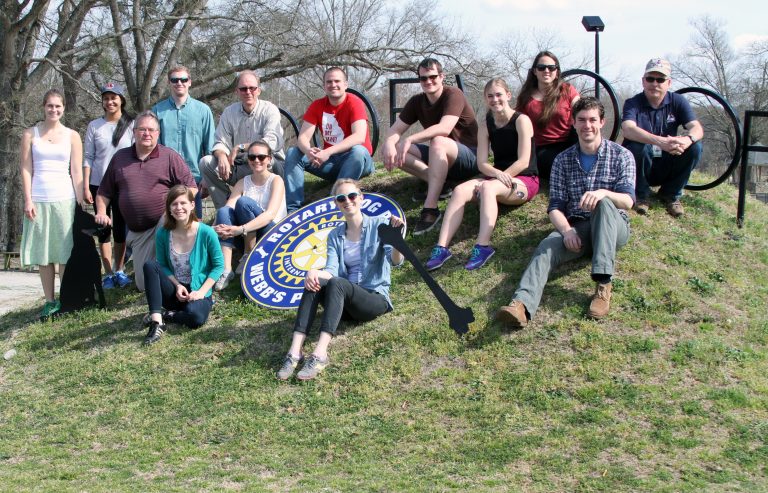
This past semester, students enrolled in certificate courses at the University of North Carolina at Chapel Hill (UNC) got the chance to ask questions of the nation’s top emergency management official and tour the facility where North Carolina officials decide on how to prepare for, respond to, mitigate against and recover from major hurricanes. They had one-on-one discussions with invited speakers, including experts ranging from the American Meteorological Society, university faculty and the United Nations.
These opportunities were part of the Natural Hazards Resilience Certificate Program. The program, which is offered by the Coastal Resilience Center (CRC) in partnership with the Department of City and Regional Planning at UNC (DCRP), is a graduate certificate program focused on the study of natural hazards resilience. As part of this course, CRC Director and DCRP Professor Gavin Smith hosted a series of speakers in class and in additional public talks during the spring semester that focused on a various topics related to natural hazards.
The graduate certificate program, which is open to students from UNC, North Carolina State University and Duke University, is composed of three required classes and one elective. The classes include “Planning for Natural Hazards and Climate Change Adaptation” (fall), “Survey of Natural Hazards and Disasters” (spring) and a “Natural Hazards Resilience Speaker Series” (spring). This spring students attended a weekly speaker series course and a separate, evening course that included two field trips to the North Carolina Division of Emergency Management’s Emergency Operations Center and a trip to Kinston, North Carolina, site of one of the largest community level efforts to relocate vulnerable communities out of the floodplain.

Federal Emergency Management Agency Administrator Craig Fugate, who spoke to a small class and a larger public group at a campus performance hall, spoke pointedly on the need to develop a “whole community” approach to more proactively address the threats posed by natural hazards and disasters.
“The speaker series course and the larger certificate program are designed to expose students to practitioners and scholars that are regarded as among the best in the field,” Smith said. “This approach allows students to gain insights that are not possible through traditional educational methods. We believe this is one component of the certificate that makes it unique.”
Lea Sabbag, a UNC DCRP graduate student, certificate participant, CRC research assistant and a Career Development Grant recipient, said she was impressed by the lineup of speakers who presented to the class.
“Rarely are students exposed to such a high caliber of guest speakers,” Sabbag said. “The insight, experience, and recommendations they were able to provide was not only exceptional from a conceptual understanding, but I was also moved by how honest they were with students. This is rare.”
Photos from the speakers series can be seen on the CRC’s Flickr page.
Building back better

As part of the “Survey of Natural Hazards and Disasters” class, students took field trips to the North Carolina Emergency Operations Center in Raleigh and to Kinston, NC. At the Emergency Operations Center, students learned about the role of North Carolina Division of Emergency Management (NCEM) in response to and recovery from disasters, and toured the facility’s “command center.”
Joe Stanton, Assistant Director for NCEM, stressed to students the importance of building back better from disasters.
“Disasters begin and end on the local level,” Stanton said. “So [at the state we strive to help communities] build back in a more resilient manner.”
Mike Daniska, Assistant Director for Planning and Homeland Security at NCEM, said that advances in emergency communications and mapping have allowed the state to better assess a community’s needs before disasters strike.
“Funding streams are down [in the last 15 years], while needs are the same or rising,” he said. “The use of good data, combined with sound analytical tools allows us to more effectively use the resources we have.”
A lasting impact
In Kinston, students learned about the town’s recovery from Hurricane Floyd in the years since 1999. The Lincoln City community, in the southeastern portion of the city of 22,000, was heavily damaged after the Neuse River crested at almost 14 feet above flood stage, destroying nearly 700 homes. FEMA and the state of North Carolina bought out properties in the 100-year floodplain, which extended about 3/4 of a mile into town from the river. Once acquired, the homes are demolished and the land maintained as open space in perpetuity. The funds provided to residents can be used to purchase a home located outside the floodplain.
In the intervening years, some former residential streets have remained blocked, and proposed uses such as parkland have largely stalled. Other flooded areas of the town have been converted into a park and nature center, and a large dog park complex, among other uses.

Ashton Rohmer, a UNC DCRP graduate student, certificate participant, CRC research assistant and a Career Development Grant recipient, said she wants to use the experience of the Kinston trip as the basis of her master’s project.
“In every class, we talk about communities that have been impacted by hazards; however, it can be hard to get the full picture of what experiences these communities had and the challenges they may continue to face after the cameras have left and the funding has run out,” Rohmer said. “Seeing the impacts on the ground in Kinston was an incredible experience as it not only provided some useful context in order to analyze the disaster recovery process, but also gave us some insight into how important implementation is.
“As planners, we spend a lot of time examining plans and thinking about the planning process, but not enough time thinking through the implementation of those plans; this is something that many municipalities (not just Kinston) struggle with, both after disasters and with standard planning exercises.”
Smith said as the certificate enters its second year, it will be improved to include further collaboration across UNC’s campus and other CRC partners.
“We are excited to welcome several incoming DCRP students this fall to the certificate program, many of whom chose to go to UNC in large part because they wanted to study natural hazards resilience,” Smith said.
The first cohort of students from the program have developed a listserv called Triangle Resilience to share information about this growing field. The tool will serve as part of a new natural hazards resilience student group that is slated to begin in September.
Interested in earning a certificate in Natural Hazards Resilience? Read and follow the links on an application form on the DCRP website.
